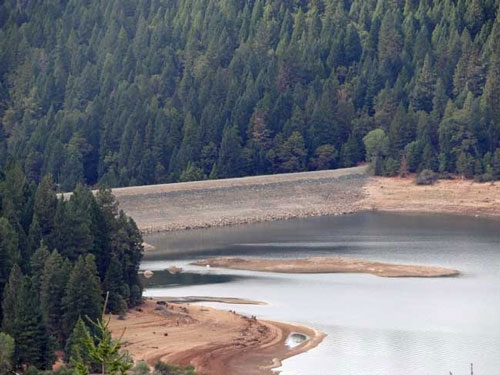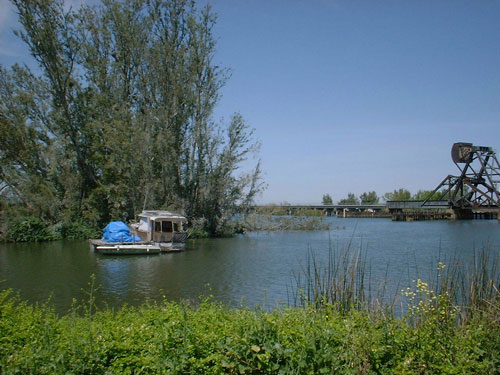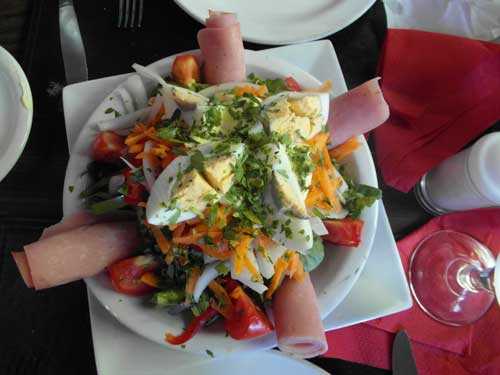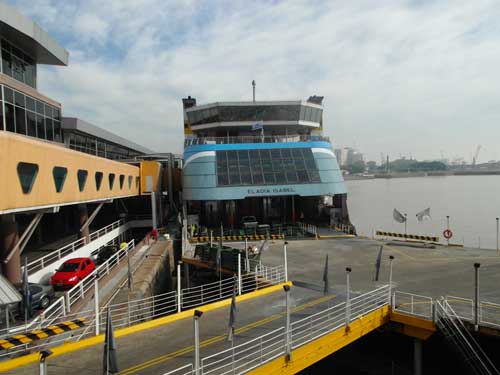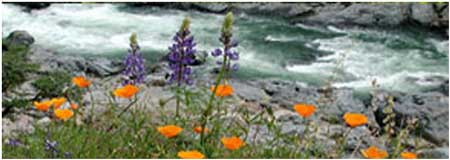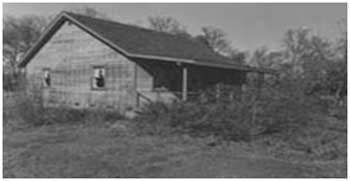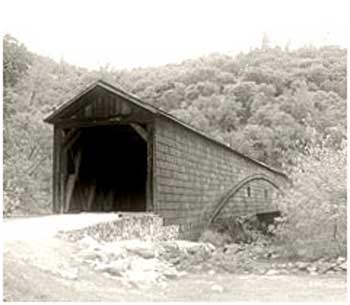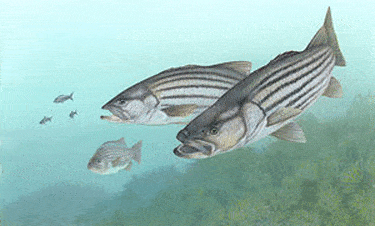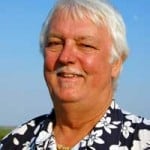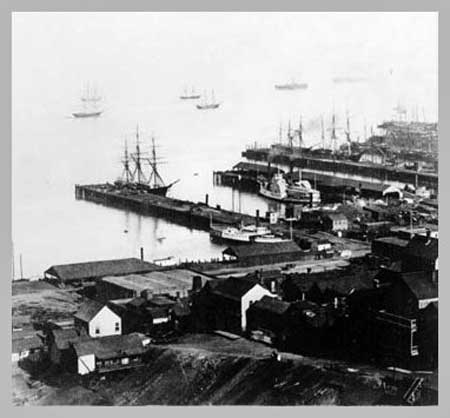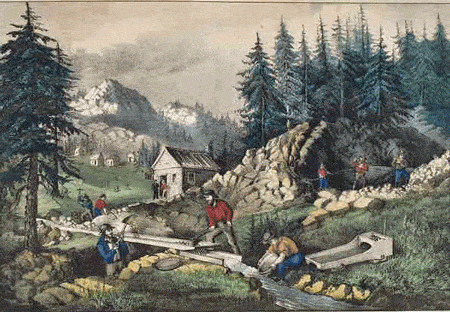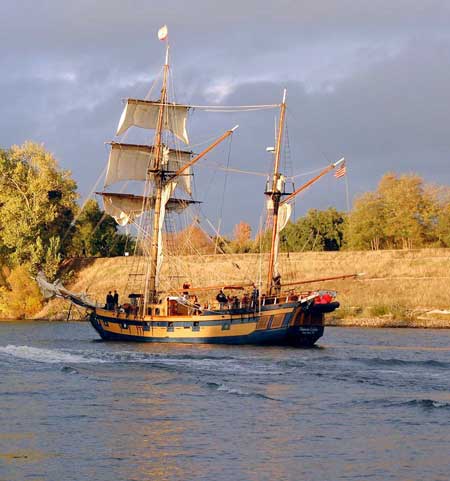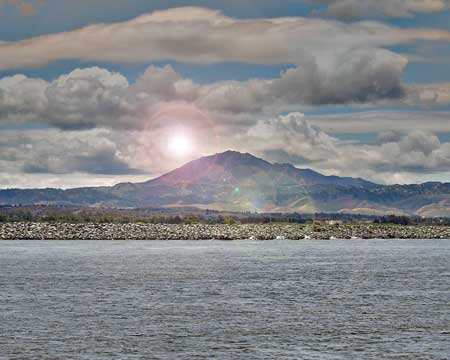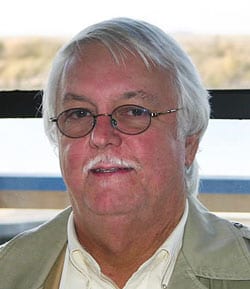Photos courtesy of Bill Wells
By Bill Wells
Agriculture
Reuben Kercheval is credited with building the first man made levees in the Delta on Grand Island about 1849. They were built from peat and only lasted a few years. In 1850 the Swamp and Overflow act which gave control of these swamplands to the state was enacted. Later the state gave control to the counties and most of the swampland was sold off. The original levees were built upon berms of material that were deposited by floods on the banks of the rivers and sloughs over thousands of years. Some of these natural levees were as much as 25 feet high. Once drained the land was prime agriculture land with fabulous peat soil that was later bagged and sold for gardens. Many early farmers were almost able to recoup the price they paid for the land with their first harvest. Sacramento-San Joaquin levees were built in the mid to late 19th Century to prevent flooding on prime agricultural land. Most of the land was at sea level, and levees were frequently constructed on top of natural dirt barriers that formed along rivers and sloughs. Originally Chinese laborers using hand shovels and wheelbarrows built most of the levees.
The trans-continental railroad was completed in 1869 with its terminus in Sacramento where passengers and goods were transferred from the railroad to the steamers plying the river for the rest of the journey to San Francisco. The railroad brought in many European immigrants from the East Coast over the next few decades.
By the turn of the 20th Century, the steam powered clamshell dredge was used to remove material from riverbeds to increase the size of levee barriers. Delta levees are built on sand, silt and peat, which makes them susceptible to erosion, seepage and breaks.
In 1917 Congress authorized the Sacramento Flood Control Project, which was completed by the U.S. Army Corps of Engineers in 1960. “Project levees” built by the Corps were designed to provide superior flood control protection. Once completed, the general upkeep was turned over to local entities. There are over 1600 miles of State-federal project levees in the Central Valley, with about 385 miles located in the Delta. Over a 40-year period about 100 clamshell dredges were used to create the geography in the Delta as we know it today.
In 1927 the bridge over the Straits of Carquinez was completed. This was also the year the majestic steamers Delta King and Delta Queen entered service to Sacramento. The writing was on the wall however and the days of the overnight steamers between Sacramento and Stockton were numbered with the advent of paved highways. There were 300 plus steamers cruising the Delta from 1849 to about 1951. The smaller ones that could ply the smaller rivers and sloughs were called “Mosquito boats” because of the huge clouds of mosquitoes they would attract when their paddle wheels churned the water. The larger ones were floating palaces with elegant food and drink as well as gambling and other activities.
Recreation
As the people of the Delta region became more prosperous they had more time for leisure and pleasure boating. The Sacramento Yacht Club is recognized as the oldest yacht club in the Delta area. The SYC started as the Capital City Boat Club in 1929 but has ties to the Undine Boat Club dating from April of 1870. Originally the club was located on the Sacramento side of the river but eventually moved to its present location on the Yolo side. The oldest yacht club in Northern California is The San Francisco Yacht Club, which began in 1869.
These days the Delta is reported to have “1,000 miles of waterways” but some publications in the 1930s mentioned 1500 miles of waterways. My recollection from the mid-1950s is that by then people were saying 1,000 miles and the late Erle Stanley Gardner mentions in his 1965 book World of water the 1,000 mile figure. That is the earliest written mention I have seen of 1,000 miles. The City of Rio Vista in their publication says 1,100 miles. Hal Schell used the figure of 1,000 miles but was always challenging people to measure the waterways. The Delta Protection Commission reports “635 miles of contiguous waterways”. Whatever the figure, there are plenty of places to visit and explore by pleasure boat and if you have a canoe, kayak or shoreboat there are even more creeks and swamps to explore that larger craft can not enter.
With the advent of the internal combustion engine around the turn of the twentieth century pleasure boats no longer had to rely on oars, sail, or steam for motivational power. Sailing vessels had problems from the time the rivers began silting in around 1870. (Steamboat Slough went from a depth of 15 feet in 1850 to 5 feet by 1870!) Steam vessels generally were larger, expensive and used large amounts of wood or coal for fuel. The gasoline engine so successfully used in automobiles was soon modified for use in boats. This opened boating to a whole new class of people. No longer were power vessels the playthings of the very affluent but were now available to middle class Americans. Small powerboats were ideal for traversing and exploring the Delta with their shallow draft and shorter length they could get into many small backwaters that the larger steamers could not.
Ship and boat construction started early in the Delta area. The first steamer to visit Sacramento was Sitka a 37-foot boat assembled at Yerba Buena (San Francisco) in 1847. Lady Washington was launched in Sacramento in August of 1849. Her owner / skipper was Peter Lassen for whom Mount Lassen was named. (Some accounts say John Sutter was the owner.) She was apparently shipped from the East Coast and assembled in Sacramento). On her maiden voyage she made it all the way to Coloma the site of Marshall’s gold discovery. Unfortunately she hit a snag and sank on the return trip. She was raised and later renamed Ohio and cruised the area until 1868.
Several boat builders made the area their home. The Nunes family were boat builders in the Azores who moved to Sausalito where they founded the famous Nunes boatyard. Along with many other famous yachts they built Zaca a beautiful schooner owned by actor Errol Flynn for several years. Some of the other builders of note in the bay and Delta were Stone Boat Yard, Stephens Brothers, Madden and Lewis, Anderson and Cristofani, Geo. Kneass, Colberg Boat Works, Besotes, and United Ship Repair.
Stephens Brothers began operation in Stockton in 1902. In 1901 two brothers Theodore and Robert Stephens built a 33 foot sloop Dorothy in their back yard on Yosemite Street in Stockton. They sailed the boat from Stockton to Santa Cruz on her maiden voyage. Soon after, they started receiving commissions to build other boats. The neighbors complained about the commercial activity going on in the back yard so the brothers purchased a barge moored in the Stockton Channel to use as a construction site. Within a few years the company was moved to its location at 745 South Yosemite Street where it remained until 1987 when it went out of business. Currently the location is the home of the fine 5 Star Marina operated by the McDonald brothers Bob and Terry. Many of the buildings today look like they did in the heyday of the business. Early on Stephens built quick open runabouts that were called “spud boats”. In 1912 a Stephens spud boat set a speed record from Stockton to San Francisco. They were used by brokers and produce dealers to roam the Delta buying crops. Speed was important, as generally the first buyer to reach a farm would purchase the crop.
These boats later evolved into pleasure boats that were both beautiful and fast. In the winter of 1925 a Siam teak hulled, Scripps powered, 26-foot Stephens runabout ran from San Francisco to San Diego in less than 24 hours, a record time. For the next several years the 26-foot runabouts carried the company financially. In 1929 Stephens started producing stock cruiser hulls which could be customized to the owner’s requirements. These would allow the owner a custom yacht at close to a production boat price. These boats did well and saw the company through the depression. Pleasure boat construction stopped at the outbreak of World War II and yards such as Stephens concentrated on building military vessels for the duration.
Plywood and Fiberglass became popular boat building materials after World War II, which further opened boating to a wider class of boaters. Likewise many war surplus vessels were converted to yachts and placed in service in the Delta. Other boats that had been seized for duty during the war found their way back into private hands, stripped of their gray paint, and varnished once again. The vessel Pat Pending owned by the Owen family of San Francisco which was mounted with a cannon and depth charges during the war and used as a submarine net tender was purchased back from the government, restored to her original beauty and cruises the Bay and Delta today.
The Lauritzens were early pioneers of the Delta. They ran Lauritzen Transportation Company and at one point had a fleet of 8 boats that moved goods and people between the bay and various Delta landings. Today Chris III and his sister Margaret run the business as one of the finest yacht harbors in the Delta located near the Antioch Bridge at the gateway to the Delta.
In 1931 the Korth family purchased land at the confluence of the San Joaquin and Mokelumne Rivers at the very Southern tip of Sacramento County. They originally planned to be farmers and grow asparagus on the property. In 1937, the Korth’s began renting out rowboats for a dollar a day. The following summer in 1938 Albine Korth decided to start building his own rowboats and his rental fleet began to grow. After World War II the Korths purchased more boats at US Government surplus auctions, and so Korth’s Pirate’s Lair as a Delta destination was beginning. During the 1940’s a snack bar was opened which evolved into the current restaurant at Korth’s. Boat sheds were constructed and the harbor was dredged and breakwater built in the 1960’s and Korth’s evolved into the fine marina that it remains today. These days the third generation of the Korth family operates three of the best marinas in the Delta with Korth’s Pirate’s Lair, Oxbow Marina, and Willow Berm Marina.
As shipping on the river declined the owners of river ports converted the docks to moor pleasure boats and converted large produce sheds into dry storage for trailer boats. Tower Park marina on Potato Slough and Boathouse Marina on the Sacramento are two examples of this strategy.
Boating expanded greatly in the Delta after the war due to the new low cost materials and the availability of surplus boats at very low prices. Many military vessels were converted to yachts, and people learned how to build a conventional pointed bow onto Higgins landing craft. With a superstructure added and cabins built inside many of these found there way into the Delta as yachts.
At this writing there are about 95 marinas with 11,700 boat slips in the Delta area and every year thousands of other boats are trailered in from all over the West coast and beyond. Many boats visit the Delta from San Francisco Bay and larger yachts travel in from West Coast ports and all over the world.
According to the Delta Protection Commission the Delta area covers about 750,000 acres with about 64,000 acres of urban areas and about 56,000 acres of waterways, and much of the remaining given to agriculture. Recreation opportunities abound with Cruising, sailing, gunkholing, water-skiing, wakeboarding, wind-surfing, camping, hunting, fishing, biking, hiking, and just hanging out all available in the Delta.
The Future
At this writing, there are many pressures on the Delta. Delta waters serves perhaps two-thirds of the population of California (about 20,000,000 legal residents) and most of this population lives in Southern California. One recent study by the University of California made a case for more of salt water intrusion in in the Delta which is supposed to help restore the ecology of the area.
Other plans call for a dam possibly at Carquinez Strait or flooding Delta Islands to store water. The peripheral canal has reared its ugly head again after lying dormant for many years. The peripheral canal is a plan to take water out of the Sacramento River well above the Delta, which will drastically reduce the water quality in the Delta. One thing is known, the next hundred years or so in the Delta will certainly be interesting!
Source:
Bill Wells
Executive Director
California Delta Chambers & Visitor’s Bureau
PO Box 1118
Rio Vista, CA 94571
916-777-4041
Click Here for California Delta Chambers Website
For all your real estate needs call or write:
John J. O’Dell
Real Estate Broker
O’Dell Realty
(530) 263-1091
Email John at jodell@nevadacounty.com
